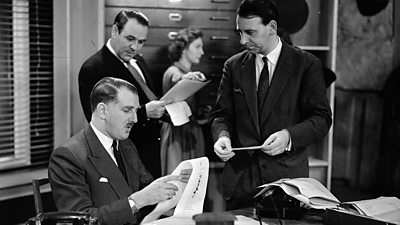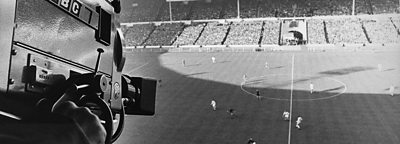Ever since John Logie Baird experimented with an outside broadcast from the Epsom Derby in June 1931 the lure of covering sport events has remained a much-loved aspect of television. The ±«Óãtv’s first live sport broadcast was a boxing match from, and later that year engineers were able to use ultra-shortwave transmissions from the, now the longest running live outside broadcast event in the world.
Most of the innovations which transformed the cultural significance of sport on ±«Óãtv Television were introduced in the 1950s and 1960s. It was in this period that the ±«Óãtv established the conventions of televised sport which continue to echo through contemporary coverage.
Enduring programme brands such as Match of the Day and Sport Personality of the Year began in this era, as well as the previously popular sport magazine formats of Sportsview (later known as Sportsnight) and Grandstand which ran for 49 years.
The ±«Óãtv Oral History Collection contains interviews with some of the key personnel who established the ±«Óãtv’s reputation for the coverage of sport. They include: Seymour Joly de Lotbinière (Lobby) former head of both radio and television OB’s in the immediate post-War period; Peter Dimmock who succeeded Lobby as General Manager of OB’s; Sir Paul Fox the editorial driving force of the ±«Óãtv’s earliest regular sport programming; Brian ‘Ginger’ Cowgill a sport producer who became the ±«Óãtv’s first Head of Sport; producer Alan Hart who succeeded him; and Ray Lakeland who looked after OB’s in the north region, including the Grand National from Aintree.
Master of the deal
Peter Dimmock had worked for the Air Ministry during the Second World War and after a short spell as a racing correspondent at Associated Press joined the ±«Óãtv in 1946. He became the man who negotiated, smooth talked and cajoled a host of sports administrators and promoters to allow the ±«Óãtv into their events and on to our screens.
In the immediate post-War-period many governing bodies were suspicious of television, fearful it might damage their attendances. In this interview with Frank Gillard, Dimmock explained how the promoters worked together to frustrate the ±«Óãtv.
In spite of the intransigence of some sport promoters Dimmock and Lobby managed to begin the process of building the ±«Óãtv’s television OB operations, most notably in readiness for the .
Throughout the period, Lobby was also central to establishing the conventions of sport commentary. For television, the general principles were to add to the picture rather than explain what viewers could already see on screen, which led to the saying "if in doubt, say nowt".
In his oral history interview, Lobby explains how the move to television was tricky to manage, especially with those who were schooled in radio broadcasting and had become household names as sport commentators.
Post-war football commentator Kenneth Wolstenholme recalled in his autobiography that Lobby had given him advice to think of the television audience as a pyramid divided into three cross sections. The top section represented the expert viewer, the middle section represented the specialist or general sports fan, the bottom section, represented the viewer with little knowledge of sport. It was to this larger constituency of viewers that commentators were to address their narrative.
In the 1950’s ±«Óãtv producers like Dimmock were frequently used as commentators as they could often remain calm when things went awry. The practice, known as "staff no fee", also saved the ±«Óãtv money by not contracting freelance commentators.
Sportsview: the first regular sport programme

In 1954 the ±«Óãtv launched a brand-new sport programme called Sportsview. The concept was the brainchild of Television Newsreel editorial assistant Paul Fox who approached Dimmock with the idea of doing a weekly sports magazine programme linked from a studio.
A previous programme Television Sport Magazine had relied on live OB’s. But Sportsview anchored filmed content from sport along with studio interviews and the occasional live OB, which was an innovative and distinct departure.
The idea was simple, recalled Fox, "a 30 minute programme looking forward and back over the week in sport". Huw Wheldon described it as a "force of all arms" meaning the combination of television resources and formats all came together for the first time.
In his interview Dimmock recalls how Sportsview came in to being and how one of the programmes many innovations was the introduction of the ‘teleprompter’, a makeshift forerunner of autocue.
Sportsview had a slice of fortune during the third programme which boosted its profile. Fox had been tipped off by Norris McWhirter that Roger Bannister was attempting to break the 4-minute-mile record at Iffley Road, Oxford.
Editor Paul Fox explained how Sportsview filmed the event on a single camera, sped Bannister to the studio and made the programme synonymous with the athlete’s achievement.
Producer Alan Hart joined Sportsview in 1959 and soon realised with an audience of 8 or 9 million viewers it "was the sort of programme that people were talking about the next day". As he recounts in his oral history interview, he joined an established group of programme makers who set the standard for sport coverage.
The Sportsview brand became synonymous with the ±«Óãtv’s involvement in sport and in 1954 the programme became the vehicle for the ±«Óãtv’s Sport Personality of the Year award.
The first winner of SPOTY was athlete Christopher Chataway, rather than record breaker Bannister. What today may seem a surprising choice by viewers in 1954, was primarily due to Sportsview’s live broadcast of Chataway’s victory over the Soviet middle-distance runner Vladimir Kutz from White City.
Grandstand: The Jewel in the Crown of ±«Óãtv Sport

Following the success of the mid-week magazine programme Sportsview, in 1958 the OB Department introduced a third regular sport programme , which took multi-sourced programming to a new level throughout Saturday afternoons.
The idea for connecting various outside broadcasts together from a studio gained momentum following the ±«Óãtv’s coverage of the British Empire and Commonwealth Games from Cardiff in 1958, where multiple sports took place in different venues on the same day.
Brian Cowgill was the first producer of the new programme, and in this interview explains the origin of the programme and how he worked closely with both engineer Bob Longman and Sports Organiser, Jack Oaten, to make the idea a reality. Key to Grandstand’s success was the use of an earpiece for the presenter to link them to the director in the gantry, as well as the ‘teleprinter’, which typed out live sporting results from the Press Association as they came in live to the studio.
Dimmock anchored the first two programmes but was soon replaced by a fresh-faced journalist from Cheshire, David Coleman. Coleman had joined the ±«Óãtv in 1954 and within a few years had deputised for Dimmock on Sportsview and Wolstenholme on Sport Special and the early evening news bulletin Today’s Sport.
Anchoring a live five-hour studio programme which stitched together multiple outside broadcasts, film recordings and a live results service required a composite set of skills. Coleman brought a deep knowledge of sport, intuitive teamwork with the director, an ability to do on-the-spot analysis and a personality with which viewers could identify. Coleman’s calm, assured presentation style led Cowgill to name him the "image and face of ±«Óãtv Sport".
For 49 years Grandstand became the ±«Óãtv’s flagship sports programme, which eventually included a Sunday version to accommodate its ever-expanding roster of live coverage from myriad sporting events. However, horse racing anchored much of the programmes live broadcast schedule every Saturday afternoon.
The jewel in Grandstand’s racing crown was the Grand National which it first broadcast in 1960 following years of negotiation by Dimmock with the larger-than-life manager of Aintree, Mirabel Topham. The ±«Óãtv’s ‘roving eye’, a camera placed on top of the Director General’s Series III Humber Super Snipe enabled tracking shots right alongside the horses as they jumped Aintree’s famous fences.
Northern producer Ray Lakeland recounted the innovations in racing coverage and his relationship with the senior managers such as Dimmock and Cowgill.
±«Óãtv Two’s Match of the Day
The ±«Óãtv’s relationships with sports promoters, often in direct competition with rival ITV, set the parameters of its coverage. Its relationship with the Football League was strained and often contrary.
Sport Special, launched in 1955, was the ±«Óãtv’s first regular programme to show filmed highlights of League matches on Saturday evenings. Processing the film was a massive logistic undertaking.
In a Radio Times article in September 1955, Dimmock explained to readers the complexities of getting film from the four corners of English football: "A helicopter, two aeroplanes, plus a fleet of moto-cycles and fast cars, will be brought in to action each Saturday throughout Britain to bring film reports of the day’s sport to your television screens the same night."
In his autobiography, football director Alec Weeks recalled how the introduction of electronic cameras and video recording in 1964 transformed the speed with which football could be edited.
"Within minutes, seconds, we could transmit: one could also record again and again on the same piece of tape; it was robust, it was cheap and its comparison with live transmission was excellent."
In August 1964, Cowgill persuaded the Chairman of the Football League, Alan Hardaker, to allow ±«Óãtv Two to experiment with the use of the video editing technology in a brand-new football programme, . The first game transmitted was Liverpool versus Arsenal, ironically, viewers in Liverpool could not receive ±«Óãtv Two at the time.
According to Weeks, the improved quality of the ±«Óãtv’s coverage of football was one reason why England was subsequently chosen to host the . Dimmock had been keen for the ±«Óãtv to introduce colour transmissions in time for the Finals, but set manufacturers protested they were not quite ready to meet the anticipated demand.
Nevertheless, as Cowgill explains, the World Cup enabled the ±«Óãtv to introduce another innovation in its coverage of sport, a new piece of television technology, that he christened "action replay".
Instant action replays transformed the production practices of televised sport and our analytical gaze on sporting action forever.
Further Reading
- Richard Haynes, ±«Óãtv Sport in Black and White (2016)
- Bryan Cowgill, Mr Action Replay (2006)
- Alec Weeks, Under Aunties Skirts: The Life and Times of a ±«Óãtv Sports Producer (2006)
- Kenneth Wolstenholme, Sport Special (1958)

